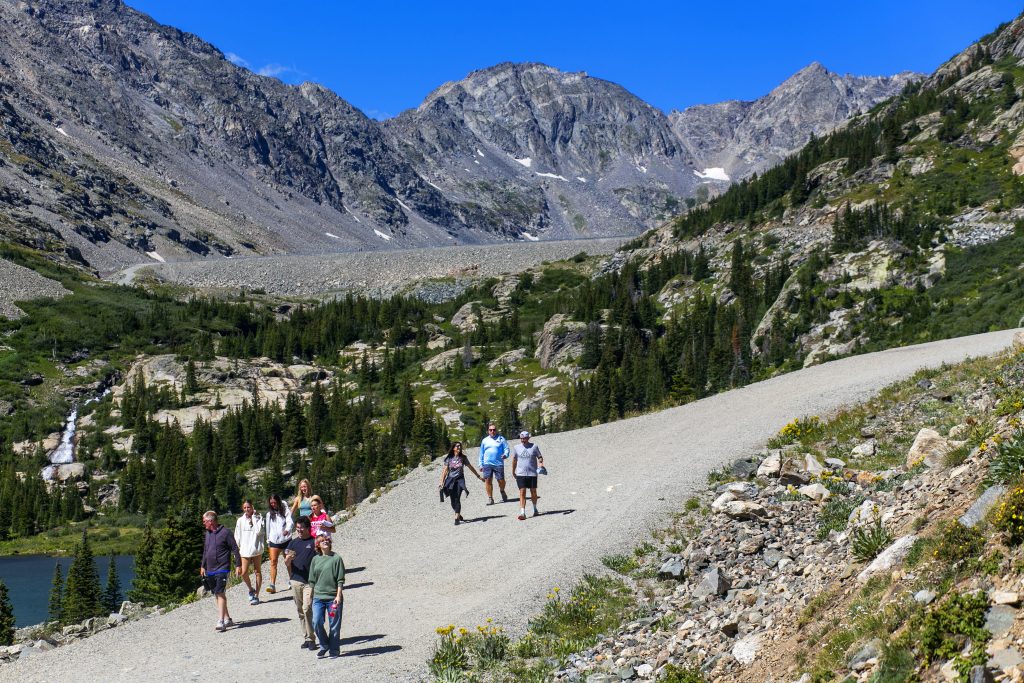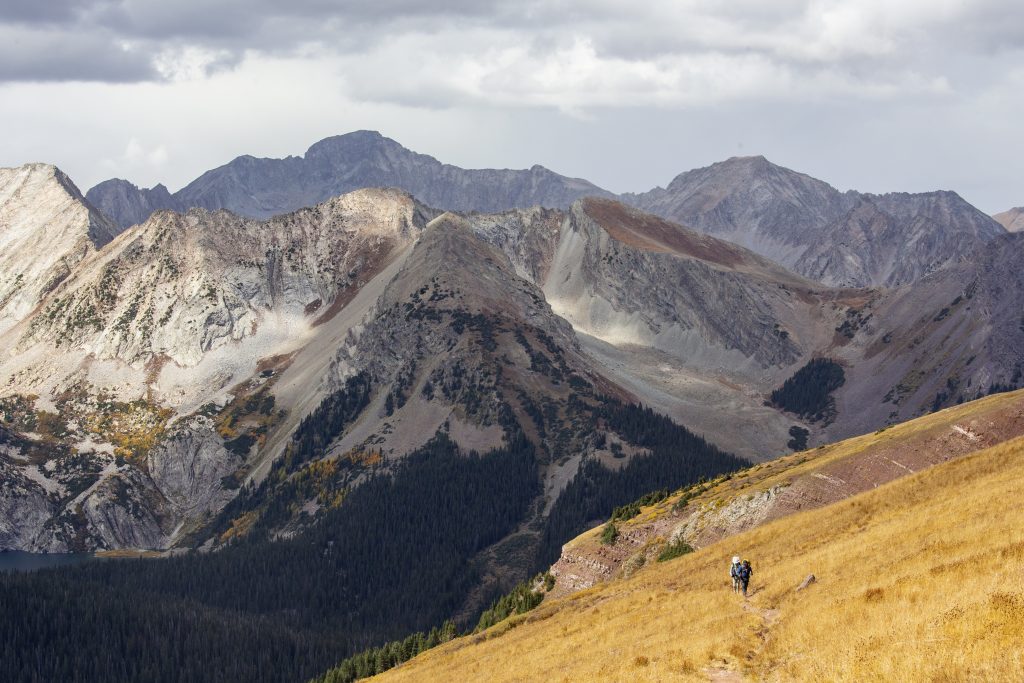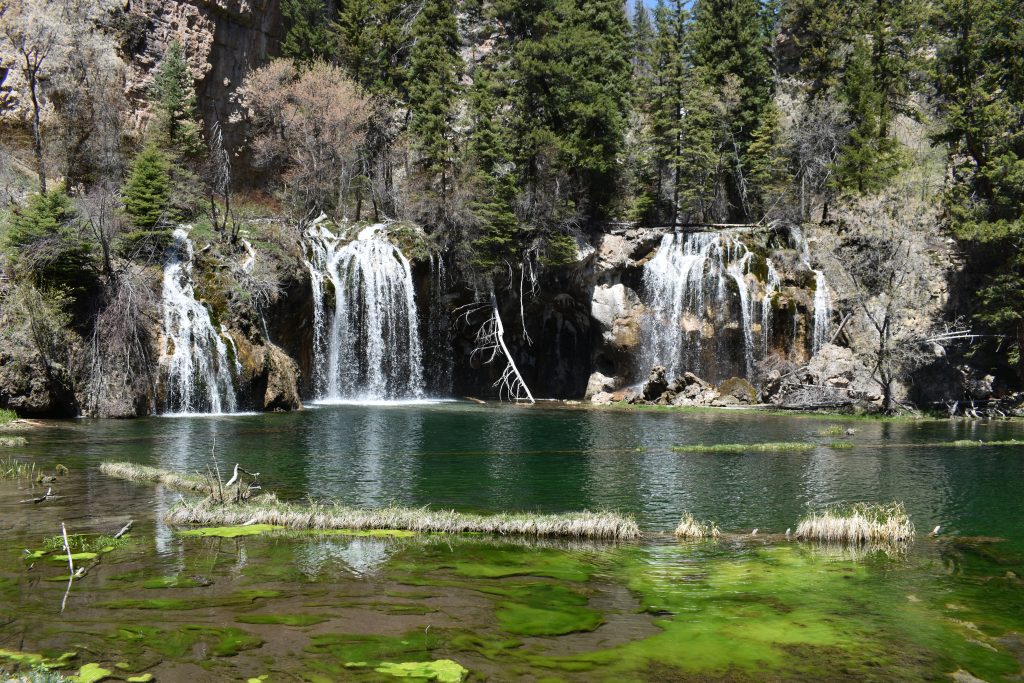 Hikers walk down Blue Lakes Road toward a trailhead near the town of Blue River in Summit County on Friday, Aug. 16, 2024. Tourism in Colorado continues to grow, with a new report from the state’s tourism office showing a 7.3% increase in travelers and a 16.8% increase in spending between 2019 and 2023. In some regions, like the central and northern mountains, growth has slowed. But outdoor leaders still worry about the environmental impacts of long-term trends.
Hikers walk down Blue Lakes Road toward a trailhead near the town of Blue River in Summit County on Friday, Aug. 16, 2024. Tourism in Colorado continues to grow, with a new report from the state’s tourism office showing a 7.3% increase in travelers and a 16.8% increase in spending between 2019 and 2023. In some regions, like the central and northern mountains, growth has slowed. But outdoor leaders still worry about the environmental impacts of long-term trends.
Andrew Maciejewski/Summit Daily News
Colorado’s tourism economy is booming, with record-high visitation and visitor spending in 2023.
The state saw 93.3 million visitors who spent $28.3 billion last year, according to a report released Aug. 5 by the Colorado Tourism Office. Compared to 2022, that’s a 3.6% increase in travelers and a 3.9% increase in spending. Looking back further to 2019, the last pre-pandemic year, the state saw a 7.3% increase in travelers and a 16.8% increase in spending.
Nearly half of the money spent by travelers in 2023 was in the Denver-metro area at $13.9 billion. The second highest region for spending was in what the report labels the “Rockies Playground,” which includes High Country and Western Slope areas like Summit, Eagle, Pitkin and Garfield counties.
The region saw $94 million more in tourism-related spending last year — a 2.3% increase from 2022 — for a total of $4.3 billion. When comparing 2019 to 2023, visitor spending increased 7.9%.
Colorado Tourism Office Director Tim Wolfe says while the numbers continue to move upward, the region is experiencing a healthy slowdown in its rate of growth.
“I think it’s good for the mountain communities because they were so busy for so long,” Wolfe said. “The last couple of years were a perfect storm. Now, you’re starting to see things more normalized.”
Get the news you want, when you want it. Sign up for daily or weekly newsletters at SummitDaily.com/newsletter
In Colorado’s High Country, much of that tourism runs through public land, namely the White River National Forest. At 2.3 million acres, White River encompasses 11 ski resorts, eight wilderness areas and popular Colorado attractions like Hanging Lake and Maroon Bells. It’s also the busiest national forest in the country.
 Two hikers climb up Buckskin Pass while completing the Four Pass Loop, a popular backpacking route near Aspen, on Sept. 28, 2022. Backcountry camping permits and fees will be implemented in 2023 for overnight stays in popular parts of Maroon Bells-Snowmass Wilderness, such as the Four Pass Loop.Andrew Maciejewski/Summit Daily News
Two hikers climb up Buckskin Pass while completing the Four Pass Loop, a popular backpacking route near Aspen, on Sept. 28, 2022. Backcountry camping permits and fees will be implemented in 2023 for overnight stays in popular parts of Maroon Bells-Snowmass Wilderness, such as the Four Pass Loop.Andrew Maciejewski/Summit Daily News
For White River Forest Supervisor Scott Fitzwilliams, the state’s latest tourism report highlights both the health of the state’s recreation economy and the continued challenges facing public land.
“The White River National Forest directly supports 22,000 jobs with an economic impact of $1.6 billion. That’s twice as much as any forest in the entire country,” Fitzwilliams said. “The long-term question is: There’s no indication on these trend lines that they are stopping. Is long-term growth along this trend line sustainable? We don’t think so.”
For Fitzwilliams, part of the answer lies in branding and called out the term “Rockies Playground” that was used in the latest tourism report.
Wolfe said the tourism office uses the term as a way to identify regions rather than for marketing purposes, adding, “We don’t promote that at all.”
Fitzwilliams said he sees reasons to avoid that language altogether.
“It is fantastic that people are getting out and enjoying their public lands … and I believe it is part of the strength of our country,” he said. “What worries me about these numbers is we are reaching the point where this is no longer sustainable if we want the other values and ecological values.”
Officials respond to growing public land use
Visitation in the Rockies Playground region, as defined by the tourism office’s report, increased by nearly 8% from 2019 to 2023. Spending on campsites in the region rose by nearly 10% during that time, though it did see a 2.3% decrease from 2022 to 2023.
Spending on day travel in the region increased 4.1% from 2022 to 2023 and 7.1% from 2019 to 2023. Part of that, Wolfe said, could be because international travel, which typically brings more overnight visitation, has not fully recovered since the pandemic.
The Forest Service conducts its own major visitation studies on a five-year cycle, with the most recent data compiled in 2017 and 2022. When looking at reports just on White River land, the numbers are more staggering.
“We went from 12.5 million visitors per year to 18.4 million visitors in five years,” a roughly 50% increase, Fitzwilliams said.
While 11.5 million of those visitors went to ski areas, 6.5 million were non-ski-area travelers. In undeveloped, wilderness areas, visitation has doubled. Growth, Fitzwilliams said, is “pretty much everywhere.”
That poses a major threat to forest ecology, from watersheds to wildlife, as well as visitor experience, Fitzwilliams said.
For example, there are 25 non-ski-area recreation sites in White River National Forest that see over 40,000 annual visitors, such as the popular Quandary Peak 14er in Summit County. Eighteen of those 25 sites don’t have a restroom, meaning there is, at a minimum, 750,000 yearly visitors at those sites without access to toilet facilities, Fitzwilliams said.
“Those people are going to the bathroom somewhere,” Fitzwilliams said. “That’s not sustainable. We’re building more lanes of highway on I-70, but we’re not building more of these facilities for when they get here.”
In recent years, Forest Service officials have turned to limited entries and permit systems, which have been deployed in popular spots like Hanging Lake and the Maroon Bells–Snowmass Wilderness, to curb crowds.
“Looking forward, I think we can expect more of that kind of timed entry, limited entry, permit system,” Fitzwilliams said. “Those are some of the tools we have.”
 Hanging Lake awaits hikers at the top of the Hanging Lake Trail on May 2, 2024. In 2019, the U.S. Forest Service and city of Glenwood Springs agreed to curtail the number of visitors to the popular Colorado attraction with a permit system that has remained in place sinceTaylor Cramer/Post Independent
Hanging Lake awaits hikers at the top of the Hanging Lake Trail on May 2, 2024. In 2019, the U.S. Forest Service and city of Glenwood Springs agreed to curtail the number of visitors to the popular Colorado attraction with a permit system that has remained in place sinceTaylor Cramer/Post Independent
Local leaders have responded similarly. Summit County officials in 2021, for example, implemented a shuttle and parking system for Quandary Peak and McCullough Gulch trails, which saw visitation flatten in 2023.
The numbers are part of a statewide trend that has seen foot traffic on 14ers drop since the highs of 2020. According to Lloyd Athearn, executive director for the Colorado Fourteeners Initiative, 2023 could be the second-lowest year for 14er foot traffic since the initiative began keeping records in 2015 — though a report is still being finalized.
Athearn said he expects 2023 numbers, once official, could be close to half of what was recorded in 2020, when 415,000 hikers ascended 14ers statewide between Memorial Day and mid-October.
“In the 14er world, that continuous uphill escalator of use is not happening,” Athearn said. “The escalator has gone down.”
Local regulations, like the ones in Summit County, are likely a contributing factor, said Athearn, who also pointed to the closure of access to Mount Lincoln and Mount Democrat by a private landowner last summer as another reason for the decline. Deals were struck so that both mountains could be reopened to the public this summer, but a waiver is required to access them.
But even with the reduction in places like Quandary, which went from a high of 49,000 recreators in 2020 to around 30,000 last year, Athearn said it may not result in less people on public lands.
“You have to look at what happened to those 20,000 people? Did they just not go, did they go somewhere else?” Athearn said. “Maybe it is improving it in one place but creating impacts elsewhere.”
He added, “We still have a lot more people than we did decades ago, and we have continued needs for protecting our resources, building out infrastructure and making sure people who recreate are well educated.”
State, regional partnerships critical for messaging
Starting this fall, White River officials will embark on a five-year process to update the forest’s management plan, which has not been revised since 2002. While the forest wasn’t scheduled to touch the plan until 2030, Fitzwilliams said he pushed that date up sooner, calling it “a really critical time” for forest management.
Fitzwilliams expects sustainable tourism will be front and center in the management plan’s next iteration.
Part of that will include identifying areas of the White River where more infrastructure is needed and — strategically — where it is not. Fitzwilliams said foresters shouldn’t be increasing parking at a site that is still relatively quiet and undisturbed. Sites that already have crowds and could absorb more with the right infrastructure, however, could be a focus for new investments.
“Those decisions come with big price tags,” Fitzwilliams said, adding that public-private partnerships will be critical to lifting some of the financial burden of the Forest Service.
The forest is looking to be proactive and not just reactive as well, with a continued emphasis on messaging, Fitzwilliams said. That includes pushing terms like Leave No Trace, which implores recreationalists to leave nature as they found it.
 A cyclist rides in front of the Maroon Bells on Saturday, July 13, 2024, near Aspen. From 2017 to 2022, visitation to the White River National Forest — home to Maroon Bells and other major outdoor destinations — grew by 53%. “The consensus is we are hitting a tipping point in parts of White River,” said Forest Supervisor Scott Fitzwilliams.Austin Colbert/The Aspen Times
A cyclist rides in front of the Maroon Bells on Saturday, July 13, 2024, near Aspen. From 2017 to 2022, visitation to the White River National Forest — home to Maroon Bells and other major outdoor destinations — grew by 53%. “The consensus is we are hitting a tipping point in parts of White River,” said Forest Supervisor Scott Fitzwilliams.Austin Colbert/The Aspen Times
Athearn, with the 14er groups, said in these areas the state needs to be a strong partner.
“Sometimes, the tourism industry can be caught up on ever-increasing numbers. … At some point, is that an extractive use?” Athearn said. “Yes, money is going to the coffee shop or the hotel. That doesn’t necessarily mean the money is flowing back to groups protecting public lands of the places people visit.”
Wolfe, the tourism office director, said destination stewardship is “critically important to us,” adding that the state agency partners with local communities on messaging tactics.
Wolfe said the tourism office’s Do Colorado Right campaign, which seeks to promote safe and sustainable tourism practices, provides a framework for local communities to build off. According to the tourism office, 19 communities, including the towns of Frisco, Breckenridge and cities of Glenwood Springs and Steamboat, have adopted their own version of Do Colorado Right.
The office also provides grant funding to local governments and organizations to aid tourism-related projects with a maximum grant amount of $20,000 with a $5,000 match. In past years, groups like the 14er initiative have used the money for digital outreach efforts to promote mountain sustainability.
This fall, the tourism office is preparing to announce a new statewide stewardship strategy plan led by its destination stewardship department, the first department of its kind within a U.S. state tourism office, Wolfe said. The statewide plan will be accompanied by eight regional plans that will bring together stakeholder groups like the Forest Service and Colorado Parks and Wildlife.
“The input from the forest service and Colorado Parks and Wildlife is built into that so that we’re hearing them loud and clear,” Wolfe said.
“Everybody’s in a different part of their tourism life cycle,” Wolfe said of the entire state. “Either, ‘We just want some people because we need money,’ or, ‘Okay, we’re very well loved, how do we fix it?’”
Source link : http://www.bing.com/news/apiclick.aspx?ref=FexRss&aid=&tid=66c00ba9118e45fba1d905cc5422b973&url=https%3A%2F%2Fwww.summitdaily.com%2Fnews%2Fcolorado-tourism-economy-sustainable-recreation-white-river%2F&c=4004678269979470613&mkt=en-us
Author :
Publish date : 2024-08-16 14:45:00
Copyright for syndicated content belongs to the linked Source.
